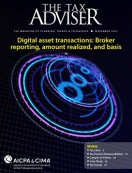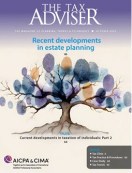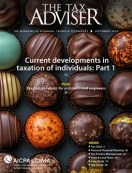- newsletter
- TAX INSIDER

When do payments to clergy move from gifts to remuneration?
A Tax Court decision should prompt CPAs with clients who are clergy to ask a few more questions.
Please note: This item is from our archives and was published in 2019. It is provided for historical reference. The content may be out of date and links may no longer function.
Related
IRS clarifies health savings account changes in H.R. 1 in new notice
IRS approves medical deduction for IVF, denies it for surrogacy
QSBS gets a makeover: What tax pros need to know about Sec. 1202’s new look
TOPICS
Are gifts to clergy taxable income for federal income tax purposes? The answer involves a careful consideration of the surrounding circumstances. In its recent opinion, Brown, T.C. Memo. 2019-69, the Tax Court considered whether amounts a clergyman and his wife nontaxable gifts, or whether they crossed the line to taxable income. The court’s decision in this case could be very informative for CPAs with tax clients who are members of the clergy.
In an audit of the 2007, 2008, and 2009 returns of Mikel A. Brown Sr., a church pastor, and his wife, Debra A. Brown, the IRS used the bank deposit method to reconstruct their taxable income. The IRS auditor analyzed the taxpayers’ bank statements and records to identify total deposits, and asked the taxpayers where the deposits came from. Deposits for which the taxpayers could not identify the source were classified as taxable by the auditor. Using this method, the IRS asserted unreported income in each of the three years under audit. The taxpayers asserted that the unreported amounts represented nontaxable gifts from church members.
Gifts: Citing a Fifth Circuit opinion, Bass v. Hawley, 62 F.2d 721 (5th Cir. 1933), which found that gifts arise from “personal affection or regard or pity,” the court focused on four criteria used in prior case law to examine payments to clergy and differentiate between payments that are nontaxable and those that are taxable:
1. Were the payments an exchange for services? For example, did they compensate for a lower salary, or were they offered in an effort to retain the clergy’s services? The court cited the size of the gifts as an indication that the payments were made to encourage Brown to remain in his position.
2. Were the payments requested by the clergy or other officials of the religious group? In this case, the court noted the use of a single envelope giving system, rather than an envelope for church contributions and an envelope for gifts to the pastor. In addition, church members gave more heavily on two specific days of the year chosen to honor the pastor, which the court found indicative that church members had been requested to give at those specified times.
3. Were the payments part of a routine, structured program? The court found that the church had a bookkeeping system that routinely collected and remitted payments to Brown. The court viewed this routine as supporting the characterization of the payments as income rather than gifts.
4. How did the amount of salary compare to the amount of the unreported payments? The unreported payments were comparable to, and in one year exceeded, the amount of salary, which the court determined supported the position that they were income, rather than gifts.
The court found the payments qualified as income rather than gifts under all four criteria, and consequently concluded that the unreported payments were taxable income.
Accuracy-related penalties: The Browns argued that the Sec. 6662(a) accuracy-related penalties the IRS imposed against them should not apply because they had relied on tax professionals to prepare their returns. Although neither of the two tax preparers who prepared returns for the Browns during the audit period had asked the Browns whether they had received any gifts, the court came to different conclusions about whether the Brown’s reliance on them was reasonable.
The court found that the preparer of the couple’s 2007 return had no knowledge of the gifts, so the Browns’ did not rely on him with reasonable cause and in good faith, and the accuracy-related penalty applied for 2007. However, the CPA who prepared the couple’s 2008 and 2009 returns had done some accounting for the church. The court determined that it was reasonable for the Browns to believe that the preparer was aware of the existence of the gifts and would report them correctly. Therefore, the court found that the taxpayers acted with reasonable cause and in good faith in relying of the preparer and consequently were not liable for an accuracy-related penalty for 2008 or 2009.
All tax practitioners should be aware that according to IRS Circular 230, Section 10.34(d), they need not verify client information, but they are required to inquire of the client in cases where information appears to be incorrect, inconsistent with an important fact or another factual assumption, or incomplete. As it is typical for clergy to receive gifts from congregants, CPAs should ask about this issue when preparing tax returns for clients who are members of the clergy.
Linda Franks, CPA, is controller at B&Z Manufacturing Company Inc. in San José, Calif. To comment on this article or suggest an idea for another article, contact Sally Schreiber, senior editor, at Sally.Schreiber@aicpa-cima.com.














